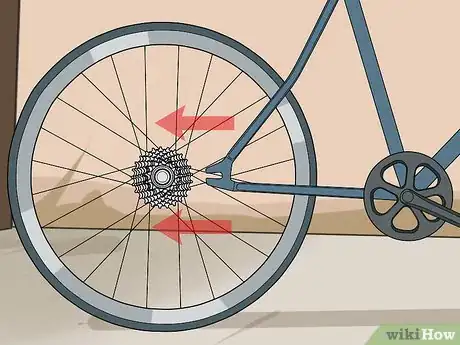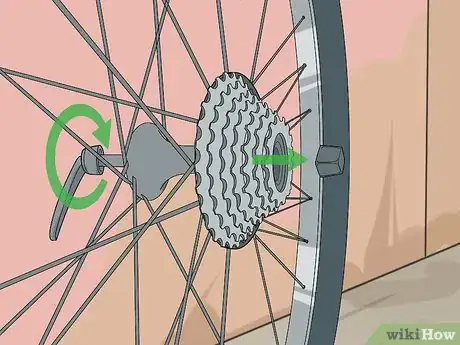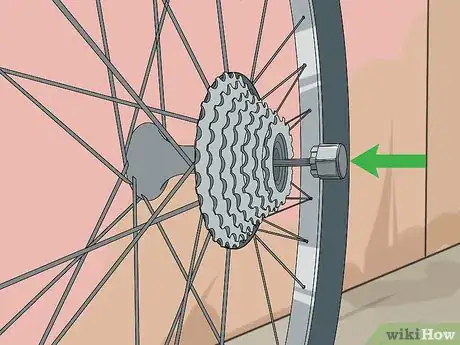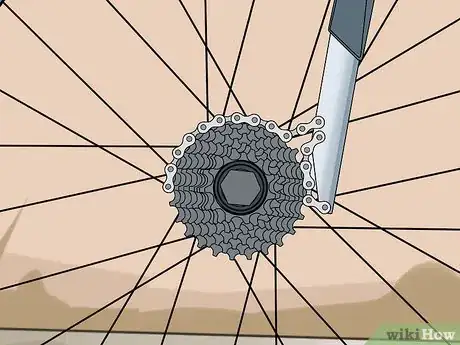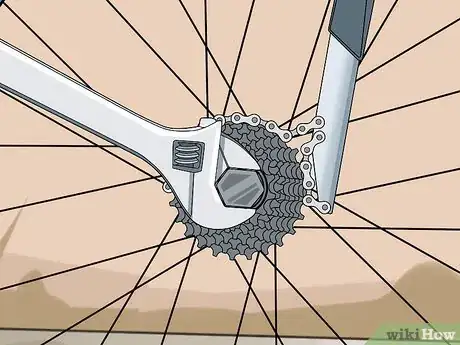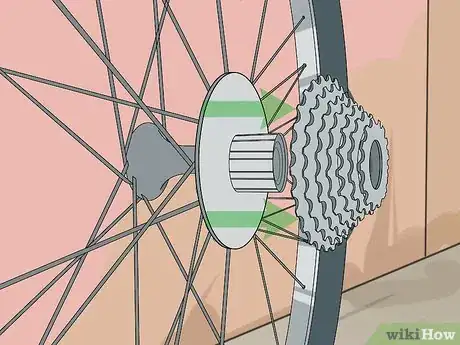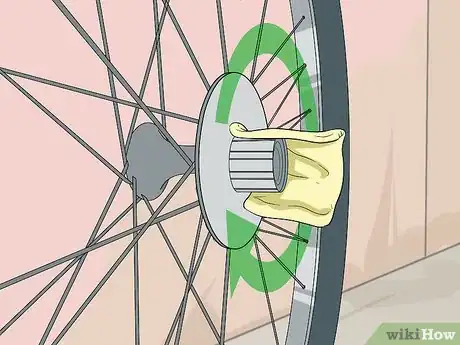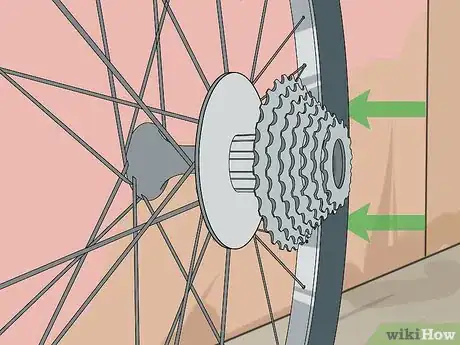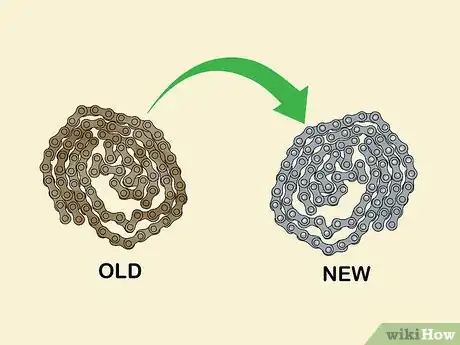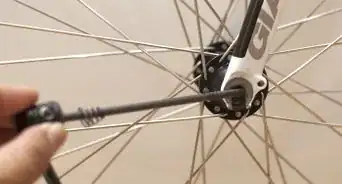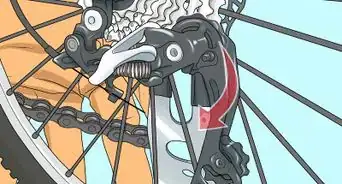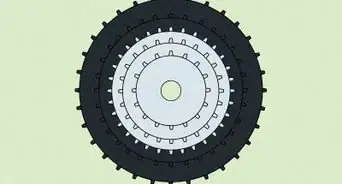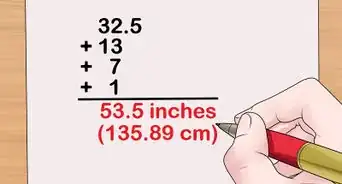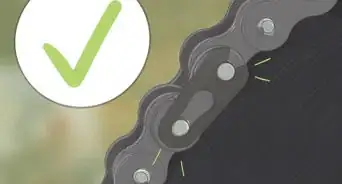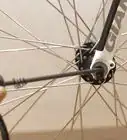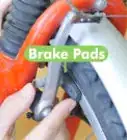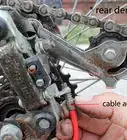This article was co-authored by Ikaika Cox. Ikaika Cox is the Shop Director at the Salt Lake City branch Bicycle Collective in Salt Lake City, Utah. He has been a bike mechanic since 2012, beginning as a volunteer with the Provo Bicycle Collective, and growing and honing his skills as a bicycle mechanic and educator in multiple Bicycle Collective locations over the years. He now leads the Salt Lake City branch of the Bicycle Collective.
wikiHow marks an article as reader-approved once it receives enough positive feedback. In this case, 80% of readers who voted found the article helpful, earning it our reader-approved status.
This article has been viewed 354,065 times.
The rear cassette is a set of concentric gear rings attached to your back wheel. Each ring is a gear on your bike, and the chain, which connects to the pedals, turns the cassette to power the bike. Over time, the teeth on the gears start to wear down, making the connection to the chain weaker and costing you valuable power. At worst, this can lead to slipped chains, which prevent you from pedaling at all until fixed.
Steps
Removing an Old Cassette
-
1Remove the wheel from the bike. This is easily done by undoing the skewer or the nuts from the axle, undoing the quick release of the brake and removing the wheel from the bike. Take the wheel off and set the bike aside.[1]
- The chain is, more likely than not, around the cassette. If you're struggling to remove it, shift the front gear into the smallest ring. Find where the chain threads through two small wheels on the derailleur arm (the shifting mechanism on your back wheel), and push to put slack in the chain.
-
2Inspect the cassette for wear and damage and confirm a cassette replacement is necessary. If the teeth are worn, they’ll be rounded rather than square. This is also a good time to give the to check for axle bearings for wear and proper lubrication. If the axle moves, the bearing cones need to be adjusted and you may need to replace the bearings in the axle. A bike shop can do this for you if you so desire. Signs you need a new cassette include:
- Skipped or slipping chain while riding.
- Issues shifting (Note: Check that your derailleurs are properly adjusted before changing the cassette)
- Visibly worn teeth (points are lower are rounder on some gears than others).
- Cracked, broken, or warped gears.
Advertisement -
3Remove the skewer. Put the wheel on a flat surface with easy access to the cassette and remove the skewer, which is the long rod running through the center of the wheel. More often than not, the skewer and mating bolt on the other end can be easily screwed off by hand.
-
4Place your lockring removal tool into the center of the cassette. Replace the skewer with a lock ring removal tool. It will have a grooved ring on the end that locks it into the cassette. This will be your pressure point to unscrew the cassette.
- Some older lock-rings don't have attached skewers. They are meant to replace the bolts on your own skewer, then used like normal. Unscrew the normal ends and put the lockring removal tool on your old skewer to use.
-
5Wrap the chain whip around the largest sprocket in a counter-clockwise direction. Choose the largest sprocket you can get the chain around. The chain whip keeps the cassette from turning while you unscrew it. It is simply a long handle with about 6 to 8 inches (15 to 20 cm) of bike chain at the end, which allows it to lock the cassette in place. Wrap as much of the chain as you can around one of the largest gears, going counter-clockwise.
- To loosen the bolt later you will need to turn the lockring counter-clockwise, so the chain whip will pull the the cassette clockwise -- this is the opposing pressure to keep everything steady.
- Alternatively, use a length of chain instead.
-
6Clamp a large adjustable wrench on your lockring removal tool. Use the wrench to hold the chain whip in place. If you're just starting out, this might be easier with two people. Tighten the adjustable wrench around the lockring tool so that you can get a lot of power on it.
- Make sure the tool is firmly jammed in the cassette. This is easily recognizable by the 12-tooth lock nut on the cassette.
-
7Holding the chain whip in place, turn the wrench counter-clockwise to release the lock-ring. This nut has a regular thread that needs to be rotated in an counterclockwise direction. It will probably take some force, and may make a loud grinding noise, which sounds like popcorn, as it is removed. This is because of the locking teeth. While you don't want to break anything, know that this takes a fair amount of force, especially if never done before.
- All this takes off is the lock ring, the small, usually silver piece that prevents the cassette from moving.
- Set the lock ring aside in a careful place -- you definitely do not want to lose these!
-
8Slide the cassette off after removing the lock ring. Usually, it consists of a few sprockets, spacers, and a large set of sprockets riveted together. Keep everything in the same order you took it out in as a guide for adding your new cassette. There may also be a plastic chain guard between your cassette and the spokes of the wheel -- it can be kept or discarded.[2]
- Some teeth may slide off alone, and some may be pinned together.
- You may need to use a thin object to lightly pry a few gears off.
-
9Clean the hub of the bike with an old rag and some light cleaning fluid. You rarely get to this area when cleaning, so take the time to get the gunk out now. Use an old rag and some rubbing alcohol, gentle dish soap and warm water, or Simple Green.
Replacing the Cassette
-
1Replace the cassette with the same gear ratio. First, count the number of gears. Then, count the number of teeth on the smallest gear, then the largest one. Put these numbers together to get your ratio. For example, an 11-32 should be replaced with another 11-32. You can find the tooth counts stamped on the sprockets. A part number or name would be useful as well. You can easily bring your cassette into a bike shop as well to get a near identical cassette.
-
2Replace the cassette with a different ratio. Most cassettes are interchangeable within brands for a certain number of gears. For example, Shimano sprockets (gears) can be mixed with other Shimano sprockets. Even older sprockets can be used with some adjustments. To get sprockets, buy them separately or as a whole unit. Cassettes can be disassembled by removing the pins holding them together, the pins have no other purpose than to make assembly easier. Then just stack together the cassette with the gear ratios you want. Some sprocket tooth counts are less common than others, keep that in mind when buying as you might end up with sprockets identical to what you've already got.
- It's tricky to mix and match gears, so it's best not to try unless you're experienced. Additionally, compatibility between gears and cassettes can vary. For example, a SRAM cassette may be compatible with a Shimano freehub body, but the new SRAM XD driver series isn't compatible with any older model cassettes. Similarly, Campagnolo freehub bodies are only compatible with Campagnolo cassettes. If you're in doubt about which one to use, consult your local bike shop.
- Note that changing gear ratios could require a longer or shorter chain to fit on new sized sprockets.
- The replacement cassette should have the same number of gears. For example, replace a 10-speed cassette with a 10-speed cassette instead of a 9- or 11-speed cassette.
-
3Slide the cassette back onto the hub of the bike in the order you bought them. Put your new cassette on just like you took off the old one. Note that there are a set of smaller teeth on the hub that the cassette slides into. One of them is bigger/smaller than the others. On the cassette, one of the openings is this same size, telling you how to line the new cassette up with the hub. Immediately slide the lock ring on to keep things from moving.
- You may need to add some gears one at a time. If they are separated, note any spacers (small, plastic rings) in between them when you buy the cassette. These must go on in order.
-
4Tighten the locking nut of the cassette. Use a wrench to gently tighten the lockring tool. Never over tighten this as the threads are very small and won't take much force. The cassette is fitted with locking teeth to stop it coming off, giving it the distinctive grinding or zipping sound as it is removed and replaced.
- Hand tighten the bolt as much as possible, then use the wrench to just tighten it a hair more so it doesn't move. You'll likely hear a grinding sound while you do this, which will sound like popcorn. You'll know the bolt is tight enough when you only hear 1 or 2 pops.
- The gears should all move together -- there should be no play or wobble in any of the sprockets.
-
5Refit the skewer and put the wheel back on the bike. Once the cassette is back on, put the wheel on the bike and refit the chain. You're ready to ride again.
- Always put the bike chain back near the gear the bike is in so that it doesn't clank violently when you start pedaling. If confused, shift the bike all the way to one side of the gears and put the chain on the furthest two rings on that side.
-
6Replace your chain whenever you replace your cassette. As chains wear down, the cause more and more stress on the rear cassette. In fact, proper chain replacement (every six months or so for regular riders) is the best thing you can do to prevent replacing your cassette too often. If you put a new cassette on, even if it is identical to the old one, you should replace the chain as well for the best results.[3]
Expert Q&A
Did you know you can get expert answers for this article?
Unlock expert answers by supporting wikiHow
-
QuestionCan we install gears for a hercules rocky ex 2.0 bicycle?
 Ikaika CoxIkaika Cox is the Shop Director at the Salt Lake City branch Bicycle Collective in Salt Lake City, Utah. He has been a bike mechanic since 2012, beginning as a volunteer with the Provo Bicycle Collective, and growing and honing his skills as a bicycle mechanic and educator in multiple Bicycle Collective locations over the years. He now leads the Salt Lake City branch of the Bicycle Collective.
Ikaika CoxIkaika Cox is the Shop Director at the Salt Lake City branch Bicycle Collective in Salt Lake City, Utah. He has been a bike mechanic since 2012, beginning as a volunteer with the Provo Bicycle Collective, and growing and honing his skills as a bicycle mechanic and educator in multiple Bicycle Collective locations over the years. He now leads the Salt Lake City branch of the Bicycle Collective.
Bicycle Mechanic For this model, you'll need to replace the single-speed wheel with a geared one. Then, install a bolt-on derailleur hanger, which will allow you to fit a derailleur on your bike. Next, install a shifter, followed by a cassette and a new chain. Unfortunately, adding gears to this particular make and model can get quite expensive, costing as much as a new bike.
For this model, you'll need to replace the single-speed wheel with a geared one. Then, install a bolt-on derailleur hanger, which will allow you to fit a derailleur on your bike. Next, install a shifter, followed by a cassette and a new chain. Unfortunately, adding gears to this particular make and model can get quite expensive, costing as much as a new bike. -
QuestionCan l change my 32-tooth cassette for one with lower gears?
 Community AnswerYes, though it may be wise to adjust the length of your chain after you do that.
Community AnswerYes, though it may be wise to adjust the length of your chain after you do that. -
QuestionI have a flip flop rim off a road cycle fitted to my mountain bike. I was wondering if I can remove the BMX style free gear and replace it with the 7 gear cluster off my mountain bike rim?
 Community AnswerIt depends on whether your mountain bike also has a freewheel and not a freehub (cassette). The difference is that a freewheel includes the ratcheting mechanism in the sprocket assembly, a freehub has the ratcheting mechanism in the hub and the sprockets can be removed separately. There is also the question of space, whether or not those 7 gears fit in the rear fork.
Community AnswerIt depends on whether your mountain bike also has a freewheel and not a freehub (cassette). The difference is that a freewheel includes the ratcheting mechanism in the sprocket assembly, a freehub has the ratcheting mechanism in the hub and the sprockets can be removed separately. There is also the question of space, whether or not those 7 gears fit in the rear fork.
Things You'll Need
- Cassette removal tool
- Large adjustable wrench of the right size
- Chain whip or a long enough length of bike chain
References
About This Article
To change a rear cassette on your bike wheel, start by removing the rear wheel from the bike. Next, remove the skewer, which is the rod running through the center of the wheel, and insert a lockring removal tool into the center of the cassette. Then, clamp an adjustable wrench on your lockring removal tool and turn it counter-clockwise to remove the lockring, followed by the cassette. Afterwards, slide the new cassette in place and tighten the locking nut with the wrench. Finally, refit the skewer and put the wheel back on the bike. To learn more, including how to clean the hub on the wheel before putting on the new cassette, read on!
